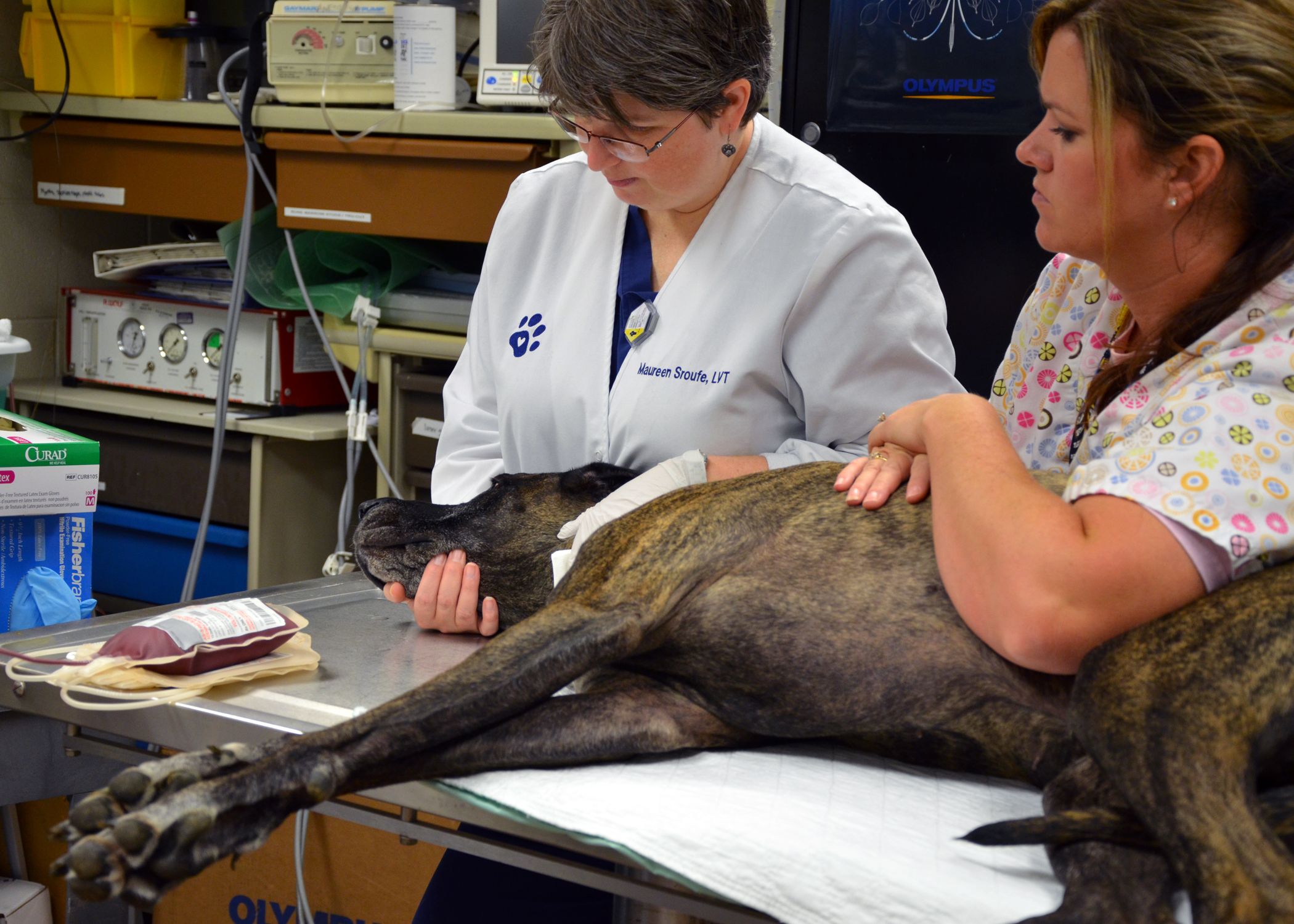Veterinary college maintains blood bank for animals

Giving the gift of life through blood donations is not only confined to humans. At the Virginia-Maryland Regional College of Veterinary Medicine, dogs and cats regularly donate blood to the college’s blood bank.
A critical supply of blood must be maintained year round at the Veterinary Teaching Hospital where both emergency and routine surgeries are daily occurrences. Dogs and cats have different blood types just like humans, so it is necessary to keep a supply of all canine and feline blood types on hand.
Dr. David Grant, associate professor of internal medicine in the Department of Small Animal Clinical Sciences, and veterinary technician Melanie Gevedon are in charge of maintaining the hospital blood bank.
“We currently have 23 canine and feline blood donors,” noted Gevedon. “The majority of these donors are owned by students and staff at the veterinary hospital and college.” Donors are solicited through announcements made in classes and flyers posted throughout the college.
Just like with human blood donations, a minimum weight exists for animal donors. An age range is also enforced. Dogs must be between one and eight years old and weigh a minimum of 50 pounds. Temperament is also important since the dog must lie quietly on its side while blood is drawn.
Feline donors must be between one and eight years old, weigh a minimum of 11 pounds, be an indoor-only cat, and the owner must agree to have the cat sedated for blood draws. Both dog and cat donors must pass several tests and screenings including health testing, vaccinations, and be in good body condition.
Owners typically bring in their dogs three to five times a year for an early morning appointment. Because the need for feline blood is not in as high demand as canine, the hospital does not store a large number of units. Instead, cat donors are on call. It’s not unusual for a cat owner to get a phone call in the middle of the night because the hospital is in need of their cat’s blood. Blood transfusions for cats are also more complicated than those for dogs because cats must receive their specific blood type.
“The donors aren’t coming in when it’s convenient for them,” said Grant. “They’re coming in when we need them.”
The donors and their caretakers do receive some compensation for their sacrifice of blood and time. Annual health care exams, vaccinations, heartworm prevention, flea prevention, worm prevention, and blood tests are covered by the hospital.
Amanda Weakley of Madison, Va., a fourth-year veterinary student, faithfully brings in her seven-year-old calico cat, Cali, to donate blood at the veterinary hospital.
“As a veterinary student, I have seen first-hand the need for blood transfusions, and the fact that Cali can supply a unit of blood for another animal is heartwarming,” said Weakley.
Cassie Wedd, a recent Doctor of Veterinary Medicine graduate from Richmond, Va., brings her seven-year-old greyhound, Reesee “Pieces” Wedd, to donate blood. However, Reesee isn’t the only one who has regular appointments to donate.
“I also try to schedule a blood donation for myself on the same day that Reesee donates. It's a good thing for both of us to do and it keeps us on a schedule,” said Wedd. “It's nice when dogs can give back to the community too.”
A sacrifice to save lives
When humans want to donate blood, they generally make an appointment at a blood center or take a trip to the local bloodmobile. Risks are very minor, and donors can donate blood, then go about their day in as little as 30 minutes.
The same can’t be said for animal donors. In addition to having to set up specific appointments or be called-in to donate, cats have to be anesthetized since they will not hold still for the draw. Just like with human anesthesia, there is always a possibility that the animal may not wake up. This has never happened at the veterinary hospital, but owners are fully aware of the risk.
“It does not deter the animals and their owners from sacrificing to save the lives of others,” noted Gevedon, who has been working with the blood bank for 14 years.
Dogs must lie on their side for their blood draw and are not anesthetized. A small portion of the dog’s neck is shaved, and the blood is drawn from the jugular vein. Each draw from a dog results in 450 milliliters of whole blood, which is then separated into one unit of packed red blood cells and two plasma units. Each draw from a dog can help as many as three other dogs.
Cat donors are anesthetized, and their blood is also drawn from the jugular vein. Each draw from a cat results in 53 milliliters of whole blood, and those packs are occasionally separated into red blood cell and plasma units, but it’s not as common as with dogs’ blood.
The need for canine or feline blood is not as high as the constant need for human blood. However, thanks to the faithful donors at the veterinary hospital, along with some supplementary purchased blood, the annual need for animal blood at the veterinary college is met.
Despite the financial compensation of free annual health care, Grant and Gevedon note that this perk doesn’t come close to the sacrifice that is made by the animals and their owners.
“The owners are willing to bring their animals here, and the animals are willing (to donate),” said Gevedon. “They’re real heroes and we just want to say how much we appreciate their sacrifice in helping us.”
Written by Carla Craft, a senior majoring in communication in Virginia Tech’s College of Liberal Arts and Human Sciences.







